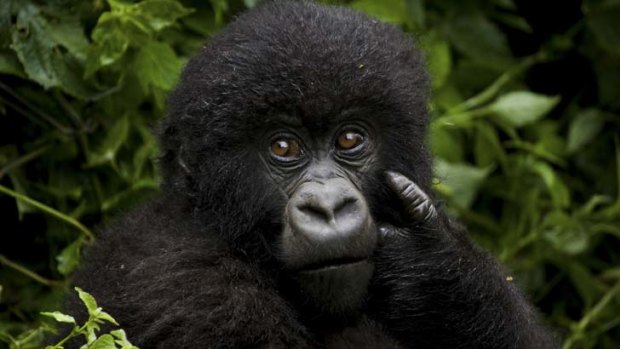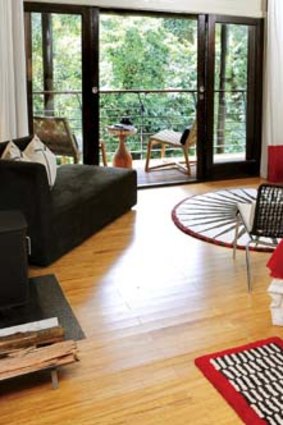
A juvenile gorilla at Volcanoes National Park.Credit: Getty Images
While walking with primates, Jeremy Head sees how a nation is using its natural assets to build a future.
What do you do when you come face-to-face with a mountain gorilla? I opted to crouch. I'd fallen behind, with my back to the rest of our trekking group, when I was confronted by a young male coming the other way. It was a moment I'll long remember. Dark, unblinking eyes fixed on me in an instant.
Then, all huge knuckles and hairy shoulders, he approached. Fascinated, I was rooted to the spot. He sauntered past, no more than 30 centimetres away from me.

Nyungwe Forest Lodge.
Rwanda is renowned for its gorillas and they didn't disappoint. In the far north-west of the country, in the Volcanoes National Park, seven groups of eight visitors get to spend an hour each day near some of the planet's last remaining mountain gorillas.
We'd set off an hour earlier after Fidel, our guide, had given us a briefing. "We're visiting the Sabyinyo group," he had said. "It comprises 12 gorillas, including the largest silverback, Guhonda. His name means 'chest beater'. All of the gorillas have names; we tell them apart by the shape of their noses."
Our trek through bamboo forest and fat-leafed foliage was relatively sedate but at nearly 2750 metres above sea level, it still occasionally had me panting for breath. During our hour with the group, which passed incredibly quickly, we were also lucky enough to get very close to Guhonda. He, too, eyed us over, almost posing.
Further turns around clumps of bamboo brought us to a huge blackback, a smaller male and a baby. We watched enthralled as he clambered and tumbled around in the bamboo. He was charming. Father looked on unperturbed as visitors just metres away snapped like mad with their cameras. It was so close, so intimate, that I felt almost embarrassed.
The choice of gorilla group was apt. The lodge where we were staying was called Sabyinyo Silverback Lodge, the most comfortable of the accommodations around the national park. It was here I was asked an unexpected question: "How is the Queen?" Merarry, the receptionist, was a keen royalist. But why? Despite its lack of a previous connection to Britain, Rwanda was officially welcomed into the Commonwealth in 2009, as the 54th and newest member.
"Do people even know what the Commonwealth is?" I asked. "For sure!" Merarry said. "We have information in the newspapers and on TV. We are very pleased. It is a good thing for our country's future."
The future is what everyone in this tiny east African country is fixed on. Putting past horrors behind them, a new generation of Rwandans is making ambitious plans for development.
This includes tapping into the business and cultural opportunities the Commonwealth offers and new allegiances with Anglophone neighbours – Kenya, Tanzania and Uganda.
Unsurprisingly, tourism is an integral part of the mix. The Rwanda Development Board (RDB) is working hard to encourage visitors to do more than just visit the gorillas. And rightly so.
A two-hour drive brought me to Kigali, the capital. The road dipped and swooped past tiny mud huts perched precariously on steep hillsides, each an island in a sea of banana and cassava plants. The warm air was full of the scent of eucalyptus and cooking smoke.
Once a backwater, Kigali now throbs with urban life – but with little of the chaos of many African cities. I shared a dinner at funky lounge bar Republika with my expatriate friends Jim and Sava and a local, Boaz.
We drank cold beer and munched burgers laced with piri piri sauce, surrounded by the hubbub of Kigali's movers and shakers. And they certainly knew how to move. Rwandans love to dance. The dance floor at Top Tower nightclub of a Friday night was packed with waggling bottoms and flailing arms to an eighth-floor backdrop of the night-time cityscape.
After the urban excitement of Kigali, I took a RwandAir flight to Kamembe in the far south-west of the country. A further one-hour drive brought me to another of Rwanda's park highlights – Nyungwe. Nyungwe is a big part of RDB's tourism plans.
Covering a massive area, it's the largest slice of protected medium-altitude rainforest in Africa, stuffed with species – orchids, birds, reptiles and, in particular, chimpanzees. It's the kind of place visitors ought to hang around longer to see.
The problem used to be the accommodation: just a cheap hostel or campsite was on offer. That has since changed. I was booked into the new Nyungwe Forest Lodge. Hidden among slopes covered with tea plants, it features designer chalets with balconies overlooking the rainforest. A 4.30am start meant there wasn't long to enjoy its comforts but the early start was worthwhile. Above me, the night sky was cloudless, with a sprinkling of stars; the wind in the rainforest was the only sound.
We picked up our excellent guide, Kambogo, and bumped along in a four-wheel-drive for an hour.
Dawn revealed pools of cloud in the valleys below, which the rising sun turned from white to gold in moments. We set off following a signpost marked Rukizi Trail. Kambogo led at a cracking pace. "The trackers radioed to say the chimps may move soon!" he said.
We forked onto a smaller trail. The slope became much steeper and the rainforest mulch under my boots more slippery.
We burst onto a wider trail to meet up with our trackers. They guided us at a gentler pace to a clearing that dropped away, offering views of enormous fig trees.
It took a while to see them but we eventually saw a family of chimps, swinging high in the trees, cramming their mouths with figs. As with the gorillas, our watching time was limited to an hour – but we were unable to get anywhere near as close this time.
Nyungwe isn't just for hardcore trekkers, though you do need to be pretty fit. There are guided walking trails, waterfalls, remarkable bird life and monkeys. The latest attraction is a 65-metre aerial walkway offering immense rainforest views. But just as we arrived it began to rain. "We can't do the walkway if it's raining. It's a safety precaution," Kambogo said. Secretly, I was relieved. I get vertigo. That drop was already making my head spin.
As we walked back, the rain became heavier. The final stretch of path revealed a huge gap in the canopy. I stepped into the gap and looked out at precipitous hills unrolling towards Lake Kivu on the horizon. Cooling rain ran down my face. Suddenly, a brief halo of sunlight lit the rainforest, with its centuries-old trees.
Amid all the excitement of progress, I thought, Rwanda's bright future is inextricably linked to the wonders of its primaeval past.
When to visit and what to expect
RWANDA can be visited at any time of year. The best time for gorilla trekking is the long dry season, from June to September, when it's not as slippery underfoot.
National park permits need to be booked well in advance, particularly for gorilla walks, because just 56 permits are issued daily. It's far easier to get your tour operator to organise them. At $US500 ($473), the permits aren't cheap but much of the revenue goes towards community work, as well as paying for the trackers, guides and rangers who protect the gorillas.
For national parks in Rwanda, you have to have a guide. There are various charges for Nyungwe National Park but examples include $US60 for the aerial walkway (with a guide) and $US90 for chimp trekking in a small group with a guide and trackers.
Volcanoes National Park isn't just about the gorillas. You can trek to see rare golden monkeys for $US100 and there's the excellent Iby'Iwacu Cultural Village run by locals, many of whom were poachers. cbtrwanda.org.
Take British pounds or US dollars and exchange for Rwandan Francs at the Forex office at Kigali Airport. International ATM access is restricted to Kigali and the machines often don't work. Hotel rooms are priced in US dollars and most hotels accept credit cards. Visa is more widely used than MasterCard.
Trip notes
Getting there
Qantas flies from Sydney to Johannesburg, priced from $1970. 13 13 13, qantas.com.au. South African Airways code-shares with RwandAir Express to fly from Johannesburg to Kigali via Nairobi, Kenya. flysaa.com. Matutu (minibuses) and cabs (taxi voiture) are available at the Kigali aiport.
Staying there
Kigali Serena is Kigali's only five-star hotel. The cool, spacious, comfortable rooms overlook a free-form, tree-fringed swimming pool. The breakfast buffet is the best in Rwanda. Rooms from $US350 ($331) a night. + 250 597 100, serenahotels.com.
Nyungwe Forest Lodge is part of the Mantis collection of privately owned boutique hotels, game reserves and ecolodges. Nyungwe has stylish bungalows with designer bathrooms and terraces looking straight on to the rainforest. Rooms from $765 a night. mantiscollection.com.
Sabyinyo Silverback Lodge, the most luxurious of the gorilla-trekking lodges, has cosy bungalows, which exude a colonial-era vibe — open fires and chunky wooden furniture. The main lodge has stunning views of distant volcanoes. Rooms from $754 a night. + 254 20 273 4000, governorscamp.com.
Touring there
Intrepid Travel has an eight-day Experience Rwanda tour priced from $3080 a person, twin share, taking place on selected dates this year. Includes Nyungwe National Park, Lake Kivu and trekking to see gorillas. A 16-day Gorillas, Chimps and Game Parks tour of Kenya, Uganda and Rwanda is priced from $2570 a person, twin share. 1300 364 512, intrepidtravel.com.
Adventure World has a four-night Mountains and Lakes tour of Rwanda beginning in Kigali and priced from $3068 a person, twin share, which includes a Volcanoes National Park gorilla trek, overnight stay at the Sabyinyo Silverback Lodge and seeing Lake Kivu. 1300 295 049, adventureworld.com.au.
More information
Sign up for the Traveller Deals newsletter
Get exclusive travel deals delivered straight to your inbox. Sign up now.